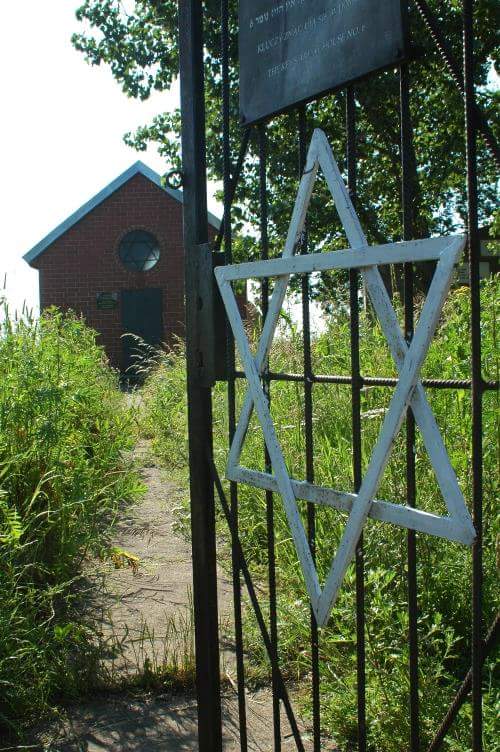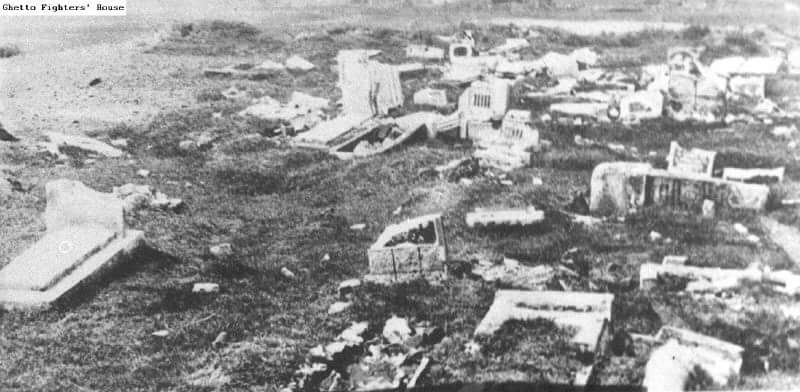 Alternate names: Sochaczew [Pol], Sochatshev, סאכאטשעוו [Yid], Sokhachev, Сохачев [Rus], Sochatchev, Sochoczew. 52°14' N, 20°15' E, 52 km (32 mi) W of Warsaw. 1900 Jewish population: 3,776. Yizkor: Pinkas Sochaczew, (Jerusalem, 1962. Sochaczew powiat is a unit of territorial administration and local government in Masovian Voivodeship, east-central Poland since January 1, 1999 with its administrative seat and only town is Sochaczew. The 2006 total population is 83,318, of which the population of Sochaczew is 37,925. [July 2009]
Alternate names: Sochaczew [Pol], Sochatshev, סאכאטשעוו [Yid], Sokhachev, Сохачев [Rus], Sochatchev, Sochoczew. 52°14' N, 20°15' E, 52 km (32 mi) W of Warsaw. 1900 Jewish population: 3,776. Yizkor: Pinkas Sochaczew, (Jerusalem, 1962. Sochaczew powiat is a unit of territorial administration and local government in Masovian Voivodeship, east-central Poland since January 1, 1999 with its administrative seat and only town is Sochaczew. The 2006 total population is 83,318, of which the population of Sochaczew is 37,925. [July 2009]
Jews lived here in the Middle Ages, at least since the prince granted the privilege of residence to the Jews in the first half of 15th century. Sochaczew kahał is first mentioned in 1507 as one of the Jewish communities taxed at the coronation of Sigismund I the Old. In 1793, 997 Jews were up to 86% of the total population, dominating trade and crafts even in the Middle Ages when as early as 1638, they traded beer and honey. At the end of the 19th century, Sochaczew an important centers of Chasidisim In 1883 Rabbi Abraham Bornstein, son-in-law Menachem Morgenstern Kocka and the student of Henocha Aleksandrów, settled here and began a yeshiva. His sons, Samuel and David, also lived here. After the Nazis captured Sochaczew, the Jews were subjected to serious repression. In January 1940, the ghetto held about 2,000 people. Czech Jews were transported to the ghetto in Zyrardow. On February 15 and 16, 1941, they were deported to Warsaw and them the camps. Few survived the Holocaust.
CEMETERY:
- Used by at least the turn of the 15th and 16th century and first documented in 1564 makes this one of the oldest Polish Jewish cemetery with Remuh in Krakow and Tykocinie. In the Middle Ages, this area was outside the city near the castle. Warsaw's Jewish community used this cemetery or Grodzisku before the founding of the Jewish cemetery in Prague. Even after the purchase of land for the Jewish cemetery in Warsaw in Brodnia, some Jews from the capitol still were buried in Sochaczew near the family graves. Distinguished members of the Jewish community buried here included many local rabbis like Charyfa Moshe Eliezer ha-Kohen Lipskera. During WWII, many executions by the Nazis occurred here. After the liquidation of the ghetto, they dug trenches for hidden Jews. After liberation, probably in 1947, many tombstones remained (possibly 250). Over the next thirty years, the remains of these tombs were stolen as courtyards of houses were paved with marble gravestones from the open, overgrown cemetery. The well-preserved section of the cemetery is approximately one-third of the total area. The other two-thirds has only occasional gravestones. (....) Between June 1950 and the spring 1952, boys with ledgers were seen on the high bank of the Bzury with the first row of graves pushing gravestones from the slope to the river in below, between 20 and 30 gravestones. The destruction of the cemetery was not the work of just one group. Destroyed was the gravestone of Paul Weinberg, the first post-war vice-mayor of Sochaczew and chairman of the local Jewish community, who was murdered in front of his shop on May 20,1945. The murders never were found. After the assassination of Weinberg, Holocaust survivors left the city. In 1981, the Office for Religious Affairs and Jews from Sochaczew tried to save the last traces of the cemetery. They surrounded by small cemetery with a metal fence with a gate with Mogen David and a narrow path built to the ohel in 1898-1990. The English sign was probably stolen, leaving only a concrete cavity. A little later in a small monument was built dozens matzevot fragments. Walking parallel to the fence, the grass, you can find several old tombstones, made of granite stones nieociosanych. A little further are traces of matzevot just above the ground. Litter left here shows that local drinkers use the site. At the end of the cemetery on the side of the slope is a single matzevot. In 1985, an exceptional matzevah from the tomb of Eliahu ben Awigdora, president of the bet din who died in 1857/8, was stored at the Academy of Fine Arts in Warsaw, awaiting to return to the cemetery. [July 2009]
- CEMETERY: The 2.8-hectare Jewish cemetery in Sochaczew was opened in the 16th century. The Jews from and was used by Jews from Warsaw (until 1780) and Łowicz until 1829). The last known burial took place in 1945. During WWII, the Nazis destroyed the cemetery, taking most of the gravestones for building the airport in Bielice. About 10 gravestones remain, the oldest of which dates from 1810. Some are boulders, but most are sandstone and granite matzevot with ornamentation and inscriptions in Hebrew, Yiddish and Polish. In 1989 the Nissenbaum Family Foundaton did maintenance work including fencing the site. In 1989, Jehuda Widawski and Jews from Sochaczew in Israel built a concrete memorial dedicated in July 1991 and inscribed in Polish: "To those murdered by the Nazis during World War II, to the Polish citizens of Jewish nationality, to the inhabitants of Sochaczew and its environs." A lapidarium was built near the memorial. In August 1993, the ohel of tzaddik Abraham Bornsztajn(d 1910) and his son Samuel was reconstructed. The key to the cemetery gate is held at Sierpniowa 6. Access is also available via the Bzury through the ruined fence. [July 2009]
- US Commission No. POCE000219
The town is located at 52º14' N 20º14' E, 72 km from Lodz and 54 km from Warszawa. Cemetery: ul. Sierpniowa in region Skierniewickie. Present town population is 25,000-100,000 with fewer than 10 Jews.
- Local: Urzad Miasta, ul. 1-go Maja, tel. 226-02.
- Regional: Wojewodzki Konserwator Zabtykow, 96-100 Skierniewice, ul. Pomologiczna 10.
- The cemetery key is held by W. Fabisiak, ul. Sierpniowa 6, tel. 232-57.
The earliest known Jewish community is 1507. 1931 Jewish population was 3,011. A ritual murder accusation was made in 1556. War with Sweden 1655-1660 effected Jewish community. Zisha Frydman-selcrtar genealry [sic] Agudat Israel lived in this Orthodox, Conservative, and Progressive/Reform community. The Jewish cemetery was established [przy puszgraline w II potoire XV w]. Abraham Bornsztajn (zm. 1910) is buried in this cemetery. Warsaw (do. 1780-54 km away) and Lowicz (do 1829-24 km away) also used this cemetery. The last known Jewish burial was 1945. Landmark: Rejestr cmentary zydowskich Ungdu ds. Wyrnan z 1981 v (or r). The urban flat land, separate but near other cemeteries, has no sign but has Jewish symbols on gate or wall. Reached by turning directly off a public road, access is entirely closed by a continuous fence with locking gate. The pre-and post-WWII size of the cemetery is 2.8 ha. 1-20 stones are visible with less than 25% toppled or broken. Some missing stones are in the Muzeum Zienu Sochacrewskiej [Museum of Sochanew Region] pl. Kosciuszki 2 and in housing near the cemetery. 1810 was the earliest known Jewish burial. The 19th and 20th century granite, limestone, sandstone, or concrete rough stone/boulder; finely-smoothed and inscribed; flat stones with carved relief decoration; sculpted monuments; or multi-stone monuments have Hebrew, Yiddish, and/or Polish inscriptions. Some have traces of painting on their surfaces. The cemetery contains special memorial monuments to Holocaust victims. There are known unmarked graves. The municipality owns the property used only for Jewish cemetery. Adjacent property is other cemeteries, residential and [szkota]. Occasionally, private visitors and organized Jewish groups visit. It was vandalized during WWII and occasionally. Local non-Jewish residents and Zwiarek Sochaczewian w Izraelu (Society of the Jews from Sochanew in Isreal) re-erected stones, fixed wall, and fixed gate in 1985-1991. Occasional clearing or cleaning by individuals is care. Within the limits of the cemetery are no structures. Security and vandalism are slight threats.
Pawel Fijatkowski, 96-500, Sochacnew, Zieninowila 11, tel. 227-91 completed survey on 12 July 1991 using a private photograph collection. He visited the site on 12 July 1991.
[UPDATE] Cemetery photos [January 2006]
Burial list [Jan 2015]
[UPDATE] Cemetery photos below from Facebook [February 2015]
[UPDATE] Facebook: photos of vandalism, with apologies for the language therein. [March 2016]
[UPDATE] Graffiti removed from Cemetery [April 2016]


